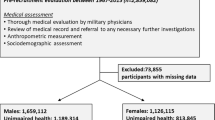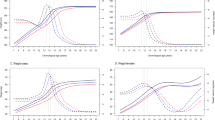Abstract
Background/Objective:
To investigate socioeconomic, gestational and early life exposures as potential determinants of total height, leg and trunk length.
Subjects/Methods:
Male subjects from the 1982 Pelotas Birth Cohort Study were examined in 1986 at home, and in 2000 when registering at the local army base. The follow-up rate was 79%. Standing and sitting heights were measured on both occasions. Leg length was calculated as the difference between standing and sitting heights. Outcome measures were height, leg and trunk length at 4 and 18 years and growth in this period. Complete data were obtained for 2012 participants, representing 71% of all eligible male subjects.
Results:
Mean (s.d.) height, trunk length and leg length at 18 years were 173.4 (6.8), 96.0 (3.5) and 77.5 cm (4.5), respectively. The mean (s.d.) change in height from 1986 to 2000 was 75.4 cm (5.2) and for leg and trunk length 35.4 (3.9) and 40.0 cm (2.9), respectively. Of 11 independent variables analyzed, only maternal height and birthweight were associated with all three variables of growth. Gestational age showed no associations with growth or attained size.
Conclusions:
Early growth plays a pivotal role in determining attained height and its components. Both biological and socioeconomic variables strongly influence determinants of height, though socioeconomic factors appear to be more important in early growth. Leg and trunk length contribute almost equally to differences in overall height, regardless of the independent variable influencing the difference. Public health strategies designed to improve chronic disease profiles should focus on the early growth period.
This is a preview of subscription content, access via your institution
Access options
Subscribe to this journal
Receive 12 print issues and online access
$259.00 per year
only $21.58 per issue
Buy this article
- Purchase on Springer Link
- Instant access to full article PDF
Prices may be subject to local taxes which are calculated during checkout

Similar content being viewed by others
References
Albanes D, Jones DY, Schatzkin A, Micozzi MS, Taylor PR (1988). Adult stature and risk of cancer. Cancer Res 48, 1658–1662.
Barros FC, Victora CG, Vaughan JP (1990). The Pelotas (Brazil) birth cohort study 1982–1987: strategies for following up 6000 children in a developing country. Paediatr Perinat Epidemiol 4, 205–220.
Barros FC, Victora CG (1999). Increased blood pressure in adolescents who were small for gestational age at birth: a cohort study in Brazil. Int J Epidemiol 28, 676–681.
Eveleth PB, Tanner JM (1976). African in Africa and the Americas. In: Cambridge University Press (ed) Worldwide Variation in Human Growth. Cambridge: Cambridge University Press. pp 75–117.
Gerver WJ, De Bruin R (1995). Relationship between height, sitting height and subischial leg length in Dutch children: presentation of normal values. Acta Paediatr 84, 532–535.
Gigante DP, Horta BL, Lima RC, Barros FC, Victora CG (2006). Early life factors are determinants of female height at age 19 years in a population-based birth cohort (Pelotas, Brazil). J Nutr 136, 473–478.
Gunnell D, May M, Ben-Shlomo Y, Yarnell J, Smith GD (2003). Height, leg length, and cancer: the Caerphilly Study. Nutr Cancer 47, 34–39.
Gunnell DJ, Smith GD, Frankel SJ, Kemp M, Peters TJ (1998a). Socio-economic and dietary influences on leg length and trunk length in childhood: a reanalysis of the Carnegie (Boyd Orr) survey of diet and health in prewar Britain (1937–1939). Paediatr Perinat Epidemiol 12 (Suppl 1), 96–113.
Gunnell DJ, Smith GD, Holly JM, Frankel S (1998b). Leg length and risk of cancer in the Boyd Orr cohort. BMJ 317, 1350–1351.
Horta BL, Victora CG, Menezes AM, Halpern R, Barros FC (1997). Low birthweight, preterm births and intrauterine growth retardation in relation to maternal smoking. Paediatr Perinat Epidemiol 11, 140–151.
Karlberg J (1989). On the construction of the infancy-childhood-puberty growth standard. Acta Paediatr Scand Suppl 356, 26–37.
Langenberg C, Hardy R, Kuh D, Wadsworth ME (2003). Influence of height, leg and trunk length on pulse pressure, systolic and diastolic blood pressure. J Hypertens 21, 537–543.
Lawlor DA, Taylor M, Davey Smith G, Gunnell D, Ebrahim S (2004). Associations of components of adult height with coronary heart disease in postmenopausal women: the British women's heart and health study. Heart 90, 745–749.
Leary S, Ness A, Emmett P, Davey Smith G (2005). Maternal diet in pregnancy and offspring height, sitting height, and leg length. J Epidemiol Community Health 59, 467–472.
Li L, Manor O, Power C (2004). Early environment and child-to-adult growth trajectories in the 1958 British birth cohort. Am J Clin Nutr 80, 185–192.
Nazmi A, Huttly SR, Victora CG, Lima RC, Post PR, Elizalde JW et al. (2007). Hb A1c in relation to intrauterine growth among male adolescents in southern Brazil. Eur J Clin Nutr 61, 434–437.
Oliveira AF, Gadelha AM, Leal Mdo C, Szwarcwald CL (2004). Study of validity in self-reported weight and height among pregnant women treated at municipal maternity hospitals in Rio de Janeiro, Brazil. Cad Saude Publica 20 (Suppl 1), S92–S100.
Silventoinen K (2003). Determinants of variation in adult body height. J Biosoc Sci 35, 263–285.
Smith GD, Greenwood R, Gunnell D, Sweetnam P, Yarnell J, Elwood P (2001). Leg length, insulin resistance, and coronary heart disease risk: the Caerphilly Study. J Epidemiol Community Health 55, 867–872.
Tanner JM, Hayashi T, Preece MA, Cameron N (1982). Increase in length of leg relative to trunk in Japanese children and adults from 1957 to 1977: comparison with British and with Japanese Americans. Ann Hum Biol 9, 411–423.
van Noord PA (2004). Breast cancer and the brain: a neurodevelopmental hypothesis to explain the opposing effects of caloric deprivation during the Dutch famine of 1944–1945 on breast cancer and its risk factors. J Nutr 134 (12 Suppl), 3399S–3406S.
Victora CG, Barros F, Lima RC, Horta BL, Wells J (2003b). Anthropometry and body composition of 18 year old men according to duration of breast feeding: birth cohort study from Brazil. BMJ 327, 901.
Victora CG, Barros FC, Lima RC, Behague DP, Gon alves H, Horta BL et al. (2003a). The Pelotas birth cohort study, Rio Grande do Sul, Brazil, 1982–2001. Cad Saude Publica 19, 1241–1256.
Victora CG, Huttly SR, Fuchs SC, Olinto MT (1997). The role of conceptual frameworks in epidemiological analysis: a hierarchical approach. Int J Epidemiol 26, 224–227.
Wadsworth ME, Hardy RJ, Paul AA, Marshall SF, Cole TJ (2002). Leg and trunk length at 43 years in relation to childhood health, diet and family circumstances; evidence from the 1946 national birth cohort. Int J Epidemiol 31, 383–390.
Zambonato AM, Pinheiro RT, Horta BL, Tomasi E (2004). Risk factors for small-for-gestational age births among infants in Brazil. Rev Saude Publica 38, 24–29.
Acknowledgements
This analysis was supported by the Wellcome Trust's initiative entitled ‘Major Awards for Latin America on Health Consequences of Population Change’. Earlier phases of the 1982 cohort study were funded by the International Development Research Center (Canada), the World Health Organization (Department of Child and Adolescent Health and Development, and Human Reproduction Programme), the Overseas Development Administration (United Kingdom), the United Nation's Development Fund for Women, the National Program for Centers of Excellence (Brazil), the National Research Council (Brazil) and the Ministry of Health (Brazil).
Author information
Authors and Affiliations
Corresponding author
Additional information
Contributors: DPG led the analysis and wrote the paper with AN and CGV. RCL conducted the 2000 Army Enlistment Study. FCB and CGV initiated the Pelotas Birth Cohort Study. All authors revised and approved the paper.
Rights and permissions
About this article
Cite this article
Gigante, D., Nazmi, A., Lima, R. et al. Epidemiology of early and late growth in height, leg and trunk length: findings from a birth cohort of Brazilian males. Eur J Clin Nutr 63, 375–381 (2009). https://doi.org/10.1038/sj.ejcn.1602949
Received:
Revised:
Accepted:
Published:
Issue Date:
DOI: https://doi.org/10.1038/sj.ejcn.1602949
Keywords
This article is cited by
-
Life course socioeconomic adversities and 10-year risk of cardiovascular disease: cross-sectional analysis of the Brazilian Longitudinal Study of Adult Health
International Journal of Public Health (2017)
-
Maternal education, anthropometric markers of malnutrition and cognitive function (ELSA-Brasil)
BMC Public Health (2014)



